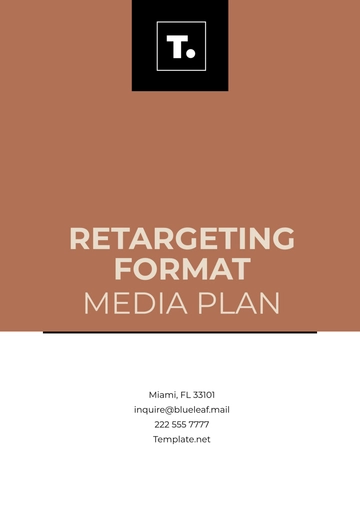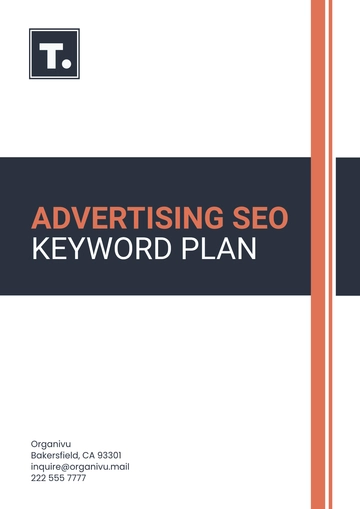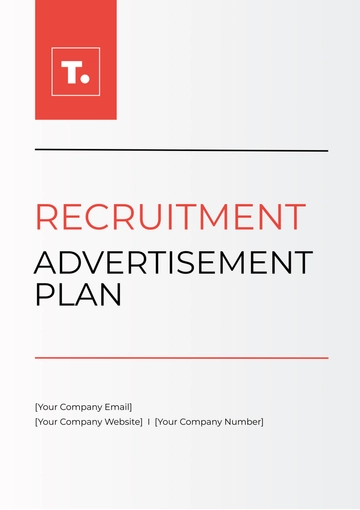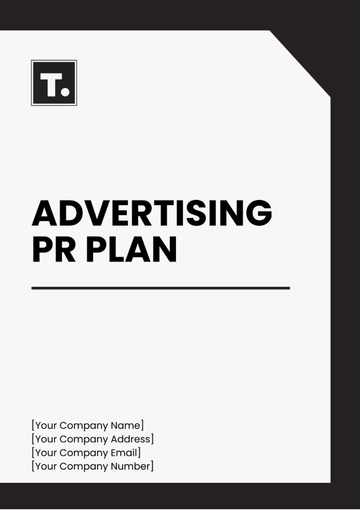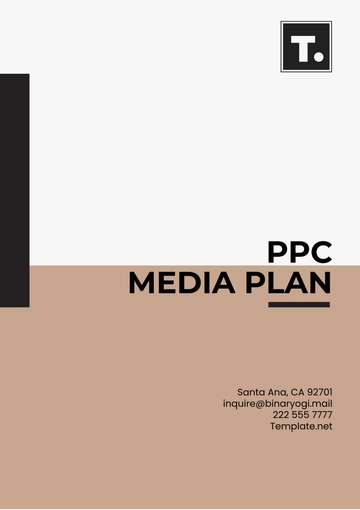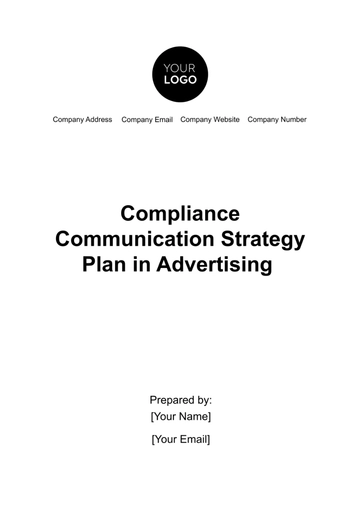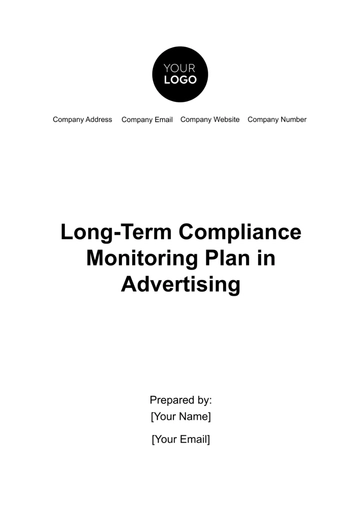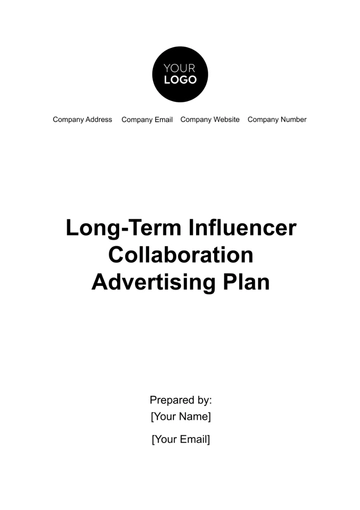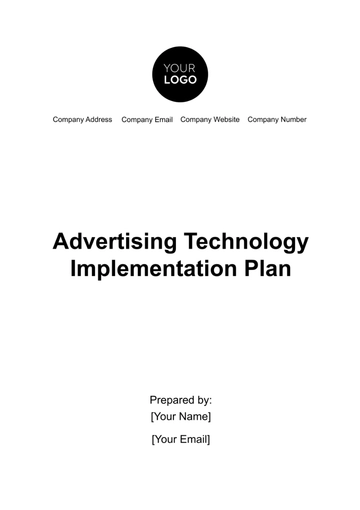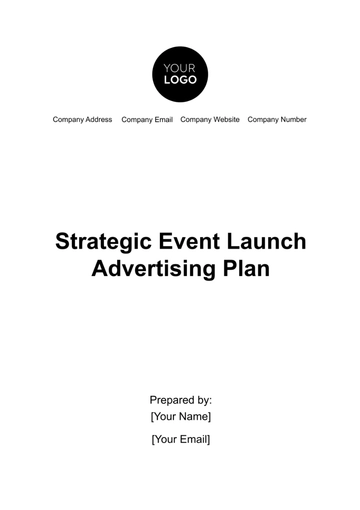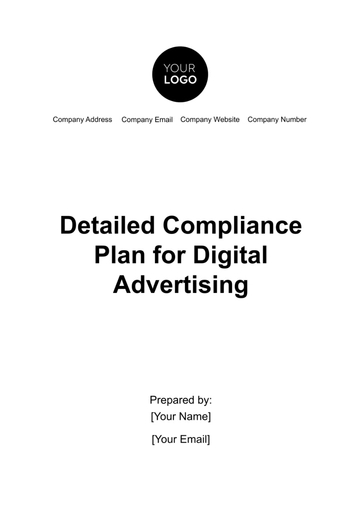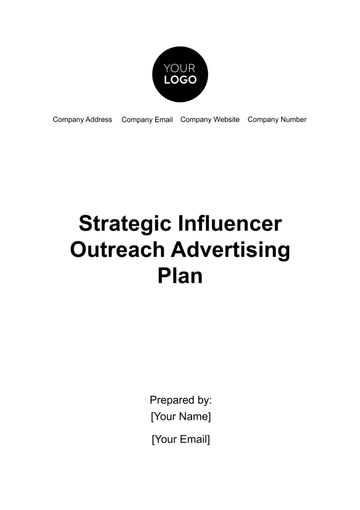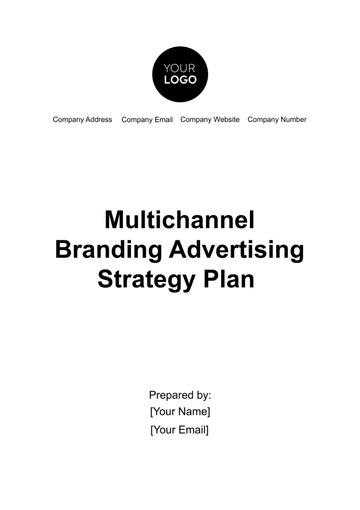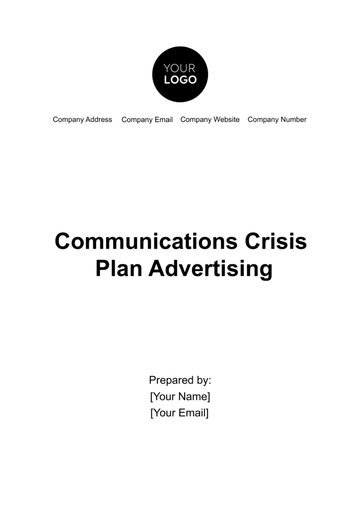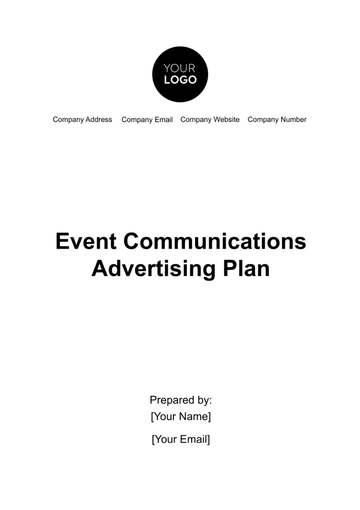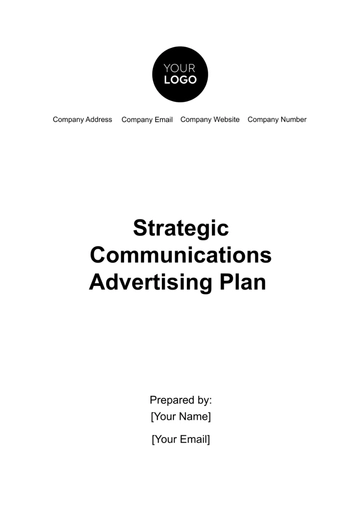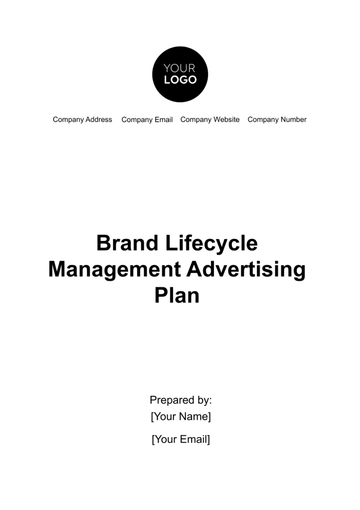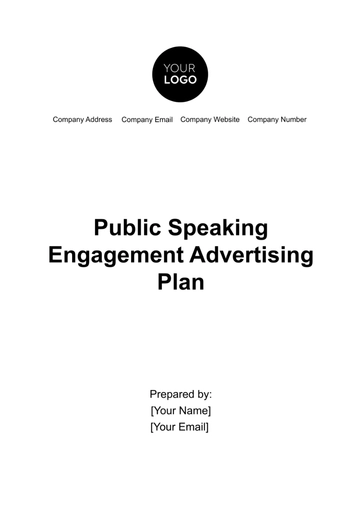Free Detailed Compliance Plan for Digital Advertising
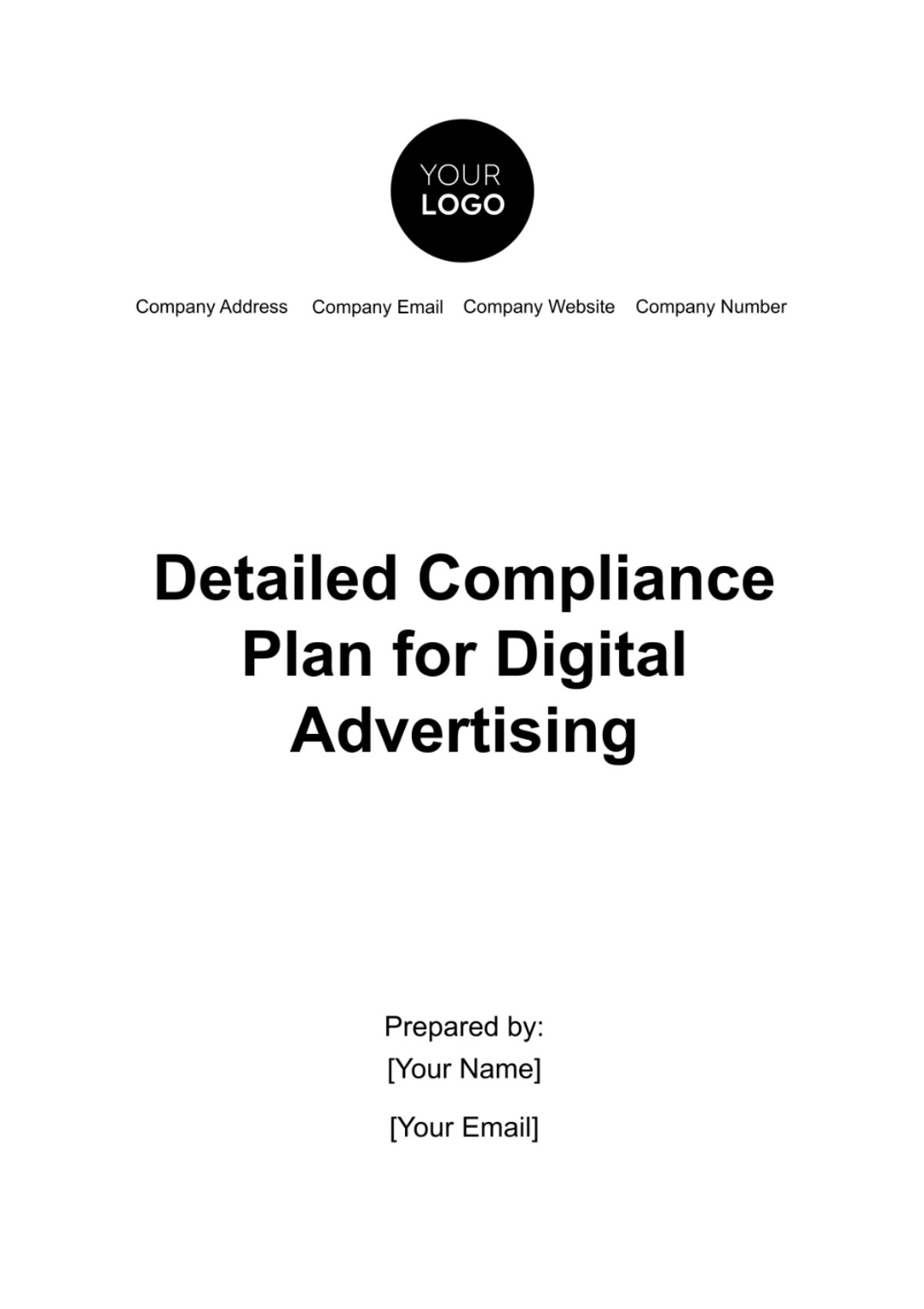
Introduction
A. Background
In the dynamic and ever-changing digital advertising landscape of 2050, [Your Company Name] has emerged as a prominent figure in the industry. As a frontrunner in delivering cutting-edge products and services, we acknowledge the pivotal importance of digital advertising in connecting with our intended audience and propelling the expansion of our business.
B. Purpose
The purpose of this Digital Advertising Compliance Plan is to establish a robust framework that ensures our digital advertising campaigns are conducted with the highest standards of legality, ethics, and transparency. In an era where data privacy and consumer trust are paramount, this plan aims to protect user data, mitigate risks, and foster trust among our clients, subscribers, and users.
C. Scope
This comprehensive plan encompasses all digital advertising activities conducted by [Your Company Name]. Our digital advertising activities span a wide range of online platforms, including websites, social media networks, search engines, mobile applications, and emerging digital spaces. The scope of this plan extends to both our direct digital advertising efforts and any partnerships or collaborations involving digital advertising campaigns.
Compliance Team
A. Roles and Responsibilities
[Your Name], Compliance Officer: As the designated Compliance Officer, your primary responsibility is to oversee and enforce compliance measures across all digital advertising activities. You will collaborate with various teams within the organization to ensure adherence to this plan.
[Your Partner Company Name], Legal Advisor: Our legal advisor from [Your Partner Company Name] will provide legal expertise and guidance to ensure that our advertising practices comply with all relevant laws and regulations.
[Your Partner Company Name], Data Protection Officer: The Data Protection Officer will play a pivotal role in ensuring data privacy compliance, including data collection, processing, and storage, aligning with applicable data protection laws.
[Your Company Name], Marketing Team: The marketing team members are responsible for implementing and integrating compliance guidelines into their digital advertising campaigns. They must collaborate closely with the Compliance Officer and Legal Advisor.
B. Communication
Effective communication is essential for the successful implementation of our compliance efforts. Regular meetings and channels of communication will be established among team members. These channels will serve as platforms for discussing compliance issues, sharing updates on regulatory changes, and reporting any incidents related to digital advertising compliance.
Regulatory Framework
A. Applicable Laws and Regulations
[Your Company Name] is committed to complying with a comprehensive set of laws and regulations governing digital advertising in 2050. These include but are not limited to:
Digital Advertising Act of 2051: This act outlines the legal framework for digital advertising practices, including data privacy, user consent, and transparency requirements.
Data Privacy Protection Act (DPPA): DPPA sets strict guidelines for the collection, processing, and protection of user data in digital advertising.
Consumer Digital Privacy Rights: We adhere to evolving consumer digital privacy rights, allowing users greater control over their data and personalized advertising experiences.
Emerging Technologies Regulations: As new technologies emerge, [Your Company Name] is committed to staying at the forefront of regulatory compliance in areas such as augmented reality (AR), virtual reality (VR), and AI-powered advertising.
B. Regulatory Agencies
To ensure proactive compliance, [Your Company Name] maintains a direct line of communication with regulatory agencies at the federal and state levels. Key agencies include:
Federal Digital Advertising Regulatory Authority (FDARA): Responsible for enforcing federal digital advertising laws and regulations.
State Digital Advertising Oversight Boards: Each state may have its own oversight board dedicated to monitoring and regulating digital advertising practices within its jurisdiction.
Data Protection Commission: This body oversees data privacy and protection regulations.
Digital Advertising Standards
A. Industry Guidelines
[Your Company Name] is committed to adhering to industry-specific advertising guidelines to ensure ethical and responsible digital advertising practices. As of 2050, some of the key industry guidelines we follow include:
Interactive Advertising Bureau (IAB) Code of Conduct: We strictly adhere to the IAB's code of conduct, which promotes transparency, user privacy, and best practices in digital advertising.
Ethical Advertisers' Association Standards: We are active members of the Ethical Advertisers' Association, and our digital advertising campaigns align with their ethical standards, emphasizing honesty, fairness, and respect.
Sustainability in Advertising Initiative: [Your Company Name] actively participates in this initiative, promoting sustainability in advertising by minimizing the environmental impact of digital advertising practices.
B. Internal Standards
To ensure consistency, quality, and brand integrity in our digital advertising efforts, [Your Company Name] has established internal advertising standards that guide our campaigns. These standards include:
Brand Messaging Guidelines: We maintain a set of brand messaging guidelines to ensure that our digital advertising campaigns convey a consistent brand image and message.
Creative Approval Process: Our creative approval process involves thorough review and validation of ad content to guarantee it complies with our internal standards.
Ethical Marketing Practices: We emphasize ethical marketing practices, ensuring that our advertising materials are truthful, transparent, and do not engage in deceptive or misleading tactics.
Data Privacy Compliance
A. Collection and Use of Data
[Your Company Name] places paramount importance on the ethical and legal collection and use of user data in digital advertising. Sample details of our data privacy compliance include:
Explicit User Consent: We obtain explicit user consent before collecting any personal data, ensuring transparency and choice for our users.
Data Minimization: We collect only the data necessary for the intended advertising purpose, minimizing the amount of user data processed.
Secure Data Storage: User data is securely stored and protected using state-of-the-art encryption and security measures to prevent unauthorized access.
B. Consent Mechanisms
We employ user-friendly consent mechanisms to obtain explicit user consent for data collection and personalized advertising. These mechanisms include:
Opt-In Consent: Users are presented with clear opt-in options, allowing them to choose whether they want to participate in personalized advertising.
Granular Consent Settings: Users have the ability to customize their consent settings, specifying which types of data they are comfortable sharing for advertising purposes.
Easy Revocation: Users can easily revoke their consent at any time through our user-friendly interface.
C. Data Protection Measures
To safeguard user data, we implement robust data protection measures, including:
Regular Security Audits: Our systems undergo regular security audits and assessments to identify and address vulnerabilities.
Data Retention Policies: We adhere to strict data retention policies, deleting user data that is no longer necessary for advertising purposes.
Data Breach Response Plan: In the event of a data breach, we have a comprehensive response plan in place to mitigate risks and protect user data.
Transparency and Disclosure
A. Advertiser Identification
In all our digital advertisements, we ensure clear and prominent identification of [Your Company Name] as the advertiser. This transparency extends to the display of our company name, logo, or other branding elements within the ad.
B. Sponsored Content
When presenting sponsored content, [Your Company Name] follows industry best practices by explicitly labeling it as "Sponsored" or "Advertisement." This clear labeling distinguishes sponsored content from organic content.
C. Affiliate Marketing
For affiliate marketing initiatives, we are committed to transparently disclosing any affiliate relationships. Users will be informed when an advertisement contains affiliate links or promotes affiliate products or services.
Ad Content Review
A. Review Process
[Your Company Name] employs a rigorous ad content review process to ensure that all digital advertisements meet our compliance standards. The process involves the following key steps:
Submission: Marketing teams submit ad creatives for review along with relevant documentation.
Legal and Compliance Evaluation: Our legal team conducts a thorough evaluation of ad content to ensure it complies with applicable laws and regulations.
Ethical Assessment: The content is assessed for ethical considerations, including truthfulness, fairness, and respect for consumers.
Data Privacy Review: The data protection team reviews ad content to ensure that user data handling aligns with privacy regulations.
Creative Integrity Check: Our creative team assesses the visual and messaging elements to ensure they align with our brand identity and guidelines.
B. Content Moderation
[Your Company Name] employs automated content moderation tools and human moderators to prevent the dissemination of inappropriate or harmful content. These tools and processes include:
Keyword Filtering: We utilize advanced keyword filtering algorithms to automatically flag and block content that may violate our content guidelines.
Image Recognition: Image recognition technology is used to identify and block content that contains explicit or sensitive imagery.
Human Review: Our dedicated team of content moderators conducts manual reviews when necessary to assess content that may require human judgment.
C. Approval Workflow
Before any digital advertisement is deployed, it must go through a structured approval workflow:
Compliance Officer Approval: The Compliance Officer reviews the ad content and ensures it aligns with all compliance measures and internal standards.
Legal Approval: Our legal team provides legal clearance, verifying that the ad complies with all relevant laws and regulations.
Creative Team Approval: The creative team evaluates the ad's messaging and creative elements to ensure consistency with our brand.
Data Privacy Review: The data protection team verifies that data privacy and consent mechanisms are correctly implemented.
Final Approval: Once all approvals are granted, the ad is considered for final deployment.
Ad Placement and Targeting
A. Target Audience
[Your Company Name] employs advanced targeting technologies to deliver digital advertisements to specific demographic groups. Our targeting strategies include:
Demographic Targeting: Ads are directed toward audiences based on demographics such as age, gender, location, and income.
Behavioral Targeting: We use user behavior data to tailor ads to individual preferences and interests.
Contextual Targeting: Advertisements are placed on websites and platforms that are contextually relevant to the content and user intent.
B. Geographical Considerations
Geo-targeting is a crucial aspect of our advertising strategy. We adhere to regional advertising laws and guidelines, ensuring that ads are appropriately tailored to specific geographic regions. This approach guarantees compliance with local regulations while enhancing ad relevance.
C. Ad Placement Guidelines
[Your Company Name] follows strict ad placement guidelines to ensure that our advertisements are displayed in appropriate contexts. These guidelines include:
Brand Safety Measures: We employ tools to avoid ad placement alongside controversial or unsafe content.
Avoidance of Sensitive Topics: Ads are not placed in proximity to sensitive or inappropriate content.
Compliance with Platform Policies: We adhere to the policies and guidelines of the advertising platforms we utilize, ensuring that our ads meet their requirements.
Incident Response
A. Reporting Incidents
[Your Company Name] maintains a robust incident reporting mechanism to promptly address and mitigate compliance incidents. Our incident reporting process includes:
Clear Reporting Channels: We provide multiple channels for reporting compliance incidents, including anonymous reporting options to encourage transparency.
Incident Documentation: When an incident is reported, detailed documentation is initiated, including the date, nature of the incident, individuals involved, and initial assessment.
Response Team Activation: An incident response team, led by the Compliance Officer, is immediately activated to assess the incident's severity and formulate an action plan.
B. Mitigation Measures
Swift and effective mitigation measures are central to our incident response strategy:
Immediate Action: Depending on the nature of the incident, immediate corrective actions are taken to mitigate any harm or potential violations.
Root Cause Analysis: A thorough investigation is conducted to identify the root causes of the incident to prevent its recurrence.
Stakeholder Communication: Relevant stakeholders are kept informed about the incident and the steps taken to address it, fostering trust and transparency.
C. Documentation
Comprehensive documentation of incidents and response efforts is maintained:
Incident Logs: A detailed log of all compliance incidents, responses, and resolutions is recorded.
Post-Incident Evaluation: After an incident is resolved, a post-incident evaluation is conducted to assess the effectiveness of the response and identify areas for improvement.
Continuous Improvement
A. Feedback Mechanism
[Your Company Name] actively seeks feedback from employees, clients, subscribers, and users to continuously enhance our digital advertising compliance efforts. This feedback mechanism includes:
User Surveys: Periodic surveys are conducted to gather user feedback regarding their advertising experiences and privacy preferences.
Internal Feedback: Employees are encouraged to provide feedback on compliance processes and suggest improvements.
Client Engagement: We engage with clients and partners to gather their input on our compliance practices.
B. Periodic Review
Our commitment to continuous improvement includes regular reviews of this compliance plan:
Annual Review: A comprehensive annual review is conducted to assess the effectiveness of our compliance measures and identify areas requiring updates.
Regulatory Monitoring: We actively monitor changes in digital advertising regulations and incorporate them into our compliance plan as needed.
C. Updates and Enhancements
Based on feedback, reviews, and regulatory changes, [Your Company Name] makes updates and enhancements to its compliance plan to ensure it remains aligned with the evolving landscape of digital advertising compliance.
Conclusion
[Your Company Name] is fully committed to maintaining the highest standards of compliance in the dynamic world of digital advertising. Our dedication to compliance is not just a regulatory obligation but a fundamental principle that underpins our business ethics and values.
By adhering to the comprehensive Digital Advertising Compliance Plan outlined in this document, we aim to achieve several critical objectives:
Protection of User Privacy: We prioritize the protection of user data and privacy, ensuring that our data collection and usage practices are in full compliance with applicable laws and regulations.
Transparency and Trust: We believe in the power of transparency. By clearly identifying ourselves as advertisers, labeling sponsored content, and disclosing affiliate relationships, we build trust with our clients, subscribers, and users.
Ethical Advertising: Our commitment to ethical advertising practices means that our campaigns are not only compliant but also fair, truthful, and respectful towards consumers.
Continuous Improvement: We view compliance as an evolving journey. Regular audits, incident responses, and feedback mechanisms are part of our commitment to continuous improvement in digital advertising compliance.
As we move forward in the ever-evolving digital advertising landscape of 2050, [Your Company Name] is resolute in its dedication to ensuring that our advertising practices remain not only compliant but also aligned with the highest ethical and transparency standards.
- 100% Customizable, free editor
- Access 1 Million+ Templates, photo’s & graphics
- Download or share as a template
- Click and replace photos, graphics, text, backgrounds
- Resize, crop, AI write & more
- Access advanced editor
Introducing the Detailed Compliance Plan for Digital Advertising Template by Template.net. This meticulously crafted resource empowers digital advertisers with an editable and customizable solution, ensuring seamless compliance adherence. With the innovative Ai Editor Tool, optimize your strategies effortlessly. Elevate your campaigns with precision and confidence.
You may also like
- Finance Plan
- Construction Plan
- Sales Plan
- Development Plan
- Career Plan
- Budget Plan
- HR Plan
- Education Plan
- Transition Plan
- Work Plan
- Training Plan
- Communication Plan
- Operation Plan
- Health And Safety Plan
- Strategy Plan
- Professional Development Plan
- Advertising Plan
- Risk Management Plan
- Restaurant Plan
- School Plan
- Nursing Home Patient Care Plan
- Nursing Care Plan
- Plan Event
- Startup Plan
- Social Media Plan
- Staffing Plan
- Annual Plan
- Content Plan
- Payment Plan
- Implementation Plan
- Hotel Plan
- Workout Plan
- Accounting Plan
- Campaign Plan
- Essay Plan
- 30 60 90 Day Plan
- Research Plan
- Recruitment Plan
- 90 Day Plan
- Quarterly Plan
- Emergency Plan
- 5 Year Plan
- Gym Plan
- Personal Plan
- IT and Software Plan
- Treatment Plan
- Real Estate Plan
- Law Firm Plan
- Healthcare Plan
- Improvement Plan
- Media Plan
- 5 Year Business Plan
- Learning Plan
- Marketing Campaign Plan
- Travel Agency Plan
- Cleaning Services Plan
- Interior Design Plan
- Performance Plan
- PR Plan
- Birth Plan
- Life Plan
- SEO Plan
- Disaster Recovery Plan
- Continuity Plan
- Launch Plan
- Legal Plan
- Behavior Plan
- Performance Improvement Plan
- Salon Plan
- Security Plan
- Security Management Plan
- Employee Development Plan
- Quality Plan
- Service Improvement Plan
- Growth Plan
- Incident Response Plan
- Basketball Plan
- Emergency Action Plan
- Product Launch Plan
- Spa Plan
- Employee Training Plan
- Data Analysis Plan
- Employee Action Plan
- Territory Plan
- Audit Plan
- Classroom Plan
- Activity Plan
- Parenting Plan
- Care Plan
- Project Execution Plan
- Exercise Plan
- Internship Plan
- Software Development Plan
- Continuous Improvement Plan
- Leave Plan
- 90 Day Sales Plan
- Advertising Agency Plan
- Employee Transition Plan
- Smart Action Plan
- Workplace Safety Plan
- Behavior Change Plan
- Contingency Plan
- Continuity of Operations Plan
- Health Plan
- Quality Control Plan
- Self Plan
- Sports Development Plan
- Change Management Plan
- Ecommerce Plan
- Personal Financial Plan
- Process Improvement Plan
- 30-60-90 Day Sales Plan
- Crisis Management Plan
- Engagement Plan
- Execution Plan
- Pandemic Plan
- Quality Assurance Plan
- Service Continuity Plan
- Agile Project Plan
- Fundraising Plan
- Job Transition Plan
- Asset Maintenance Plan
- Maintenance Plan
- Software Test Plan
- Staff Training and Development Plan
- 3 Year Plan
- Brand Activation Plan
- Release Plan
- Resource Plan
- Risk Mitigation Plan
- Teacher Plan
- 30 60 90 Day Plan for New Manager
- Food Safety Plan
- Food Truck Plan
- Hiring Plan
- Quality Management Plan
- Wellness Plan
- Behavior Intervention Plan
- Bonus Plan
- Investment Plan
- Maternity Leave Plan
- Pandemic Response Plan
- Succession Planning
- Coaching Plan
- Configuration Management Plan
- Remote Work Plan
- Self Care Plan
- Teaching Plan
- 100-Day Plan
- HACCP Plan
- Student Plan
- Sustainability Plan
- 30 60 90 Day Plan for Interview
- Access Plan
- Site Specific Safety Plan

